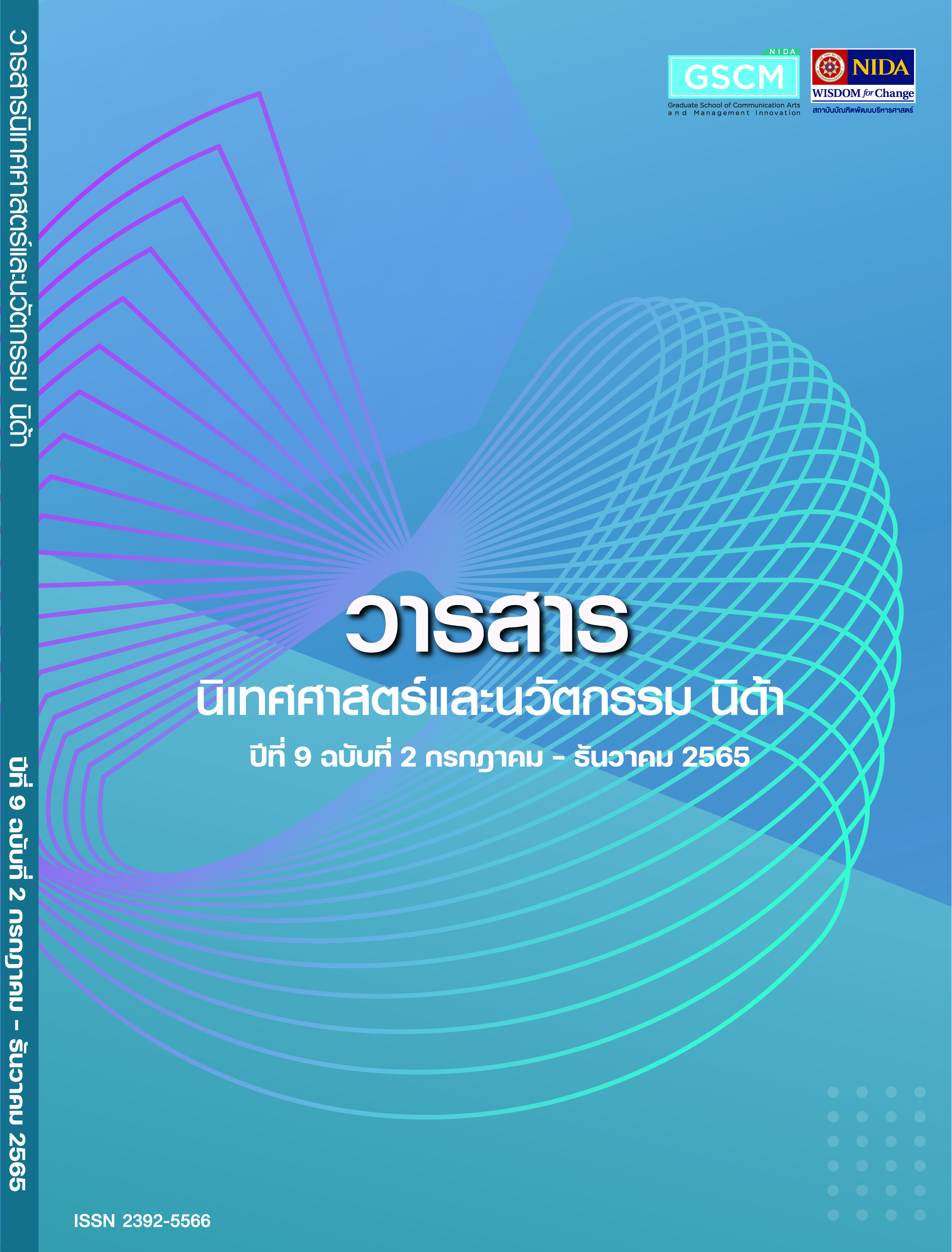Technology Acceptance, Attitude, and Social Influences Predicting Intention to Use Public Hospital Application
Main Article Content
Abstract
The purpose of this study was to study the influence of demographic characteristics, technology acceptance (i.e., perceived usefulness, perceived ease of use, perceived risk) attitude, social influences on intention of use application. Participants involved in this study were 20 years of age and older who could make decisions about accessing healthcare, health services and were familiar with the public hospital applications. This study was quantitative research by collecting data with online questionnaires of 400 participants. The results showed that demographic factors (gender, age, and educational level) affected perceived usefulness, perceived ease of use and perceived risks. The results also showed that perceived usefulness and perceived ease of use positively predicted attitudes towards using application. Attitudes toward using application positively predicted the intention to use public hospital applications. Social influences positively predicted technology acceptance (perceived usefulness, perceived ease of use, and perceived risk) and intention to use public hospital applications.
Article Details

This work is licensed under a Creative Commons Attribution-NonCommercial-NoDerivatives 4.0 International License.
ข้อความและความเห็นในวารสารนิเทศศาสตร์และนวัตกรรม นิด้า เป็นของผู้เขียนแต่ละท่าน มิใช่ของคณะนิเทศศาสตร์และนวัตกรรมการจัดการ สถาบันบัณฑิตพัฒนบริหารศาสตร์
References
กระทรวงดิจิทัลเพื่อเศรษฐกิจและสังคม. (2564). สำรวจมีการใช้เทคโนโลยีสารสนเทศและการสื่อสารในครัวเรือน พ.ศ. 2564 (ไตรมาส 3). http://www.nso.go.th/sites/2014/Pages/home.aspx
กระทรวงสาธารณสุข. (2563). รายงานข้อมูลทรัพยากรสาธารณสุขประจำปีงบประมาณ 2563. http://dmsic.moph.go.th/index/detail/8840
กิติมา สุรสนธิ. (2544). ความรู้ทางการสื่อสาร. คณะวารสารศาสตร์และสื่อสารมวลชนมหาวิทยาลัยธรรมศาสตร์.
ขนิษฐา เลิศวัฒนชัยกุล. (2562). การศึกษาปัจจัยที่มีอิทธิพลต่อการตัดสินใจใช้บริการ food delivery ผ่านแอปพลิเคชั่นในเขตกรุงเทพมหานครและปริมณฑล (การค้นคว้าอิสระปริญญามหาบัณฑิต, มหาวิทยาลัยธรรมศาสตร์). คลังทรัพยากรสารสนเทศอิเล็กทรอนิกส์ของมหาวิทยาลัยธรรมศาสตร์. https://digital.library.tu.ac.th/tu_dc/frontend/Info/item/dc:174065
คณะแพทยศาสตร์ศิริราชพยาบาล. (2564). สถิติ_SirirajConnect_ส่งให้นักศึกษาป.โท. เอกสารไม่ได้ตีพิมพ์
เดชพงศ์ นาคเสวี. (2557). การประเมินผลการยอมรับการใช้ระบบสารสนเทศโรงพยาบาลของศูนย์ศรีพัฒน์ คณะแพทยศาสตร์มหาวิทยาลัยเชียงใหม่ (การค้นคว้าอิสระปริญญามหาบัณฑิต, มหาวิทยาลัยเชียงใหม่). คลังสารสนเทศดิจิทัลของมหาวิทยาลัยเชียงใหม่. https://cmudc.library.cmu.ac.th/frontend/Creator/personDc/87061
ธนพร ทองจูด. (2564). การศึกษาปัจจัยของการตรวจรักษาด้วยโทรเวชกรรมที่มีผลต่อทัศนคติและความตั้งใจเลือกใช้บริการโทรเวชกรรมของผู้รับบริการของโรงพยาบาลรามาธิบดี (สารนิพนธ์ปริญญามหาบัณฑิต, มหาวิทยาลัยมหิดล). คลังฐานข้อมูลวิทยาลัยการจัดการของมหาวิทยาลัยมหิดล. https://archive.cm.mahidol.ac.th/handle/123456789/4198
พัชราวดี เลิศปัญญาพล. (2563). ความตั้งใจในการใช้บริการแอปพลิเคชันโทรเวชกรรม (การค้นคว้าอิสระปริญญามหาบัณฑิต, มหาวิทยาลัยธรรมศาสตร์). คลังทรัพยากรสารสนเทศอิเล็กทรอนิกส์ของมหาวิทยาลัยธรรมศาสตร์. https://digital.library.tu.ac.th/tu_dc/frontend/Info/item/dc:186081
ภัทรพร หินเจริญ. (2561). ปัจจัยการยอมรับการใช้โปรแกรมการดูแลสุขภาพของข้าราชการพลเรือนในจังหวัดนนทบุรี (วิทยานิพนธ์ปริญญามหาบัณฑิต, มหาวิทยาลัยธรรมศาสตร์). คลังทรัพยากรสารสนเทศอิเล็กทรอนิกส์ของมหาวิทยาลัยธรรมศาสตร์. https://digital.library.tu.ac.th/tu_dc/frontend/Info/item/dc:148491
โรงพยาบาลจุฬาลงกรณ์. (2564). 20220225_Chula Care_Performance_2021_sent. เอกสารไม่ได้ตีพิมพ์
วิกานดา พรสกุลวานิช. (2565ก). สื่อใหม่และการจัดการการสื่อสาร. สำนักพิมพ์มหาวิทยาลัยธรรมศาสตร์.
วิกานดา พรสกุลวานิช. (2565ข). สื่อและผลของการสื่อสารในยุคดิจิทัล. สำนักพิมพ์ มหาวิทยาลัยธรรมศาสตร์.
ศตพล เกิดอยู่. (2558). ทัศนคติ พฤติกรรม และการรู้เท่าทันการใช้แอปพลิเคชันไลน์ของกลุ่มวัยเบบี้บูมเมอร์ (วิทยานิพนธ์ปริญญามหาบัณฑิต, มหาวิทยาลัยธรรมศาสตร์). คลังทรัพยากรสารสนเทศอิเล็กทรอนิกส์ของมหาวิทยาลัยธรรมศาสตร์. https://digital.library.tu.ac.th/tu_dc/frontend/Info/item/dc:93550
สุธาสินี ตุลานนท์. (2562). การยอมรับเทคโนโลยีที่มีผลต่อการตัดสินใจซื้อสินค้าออนไลน์ของผู้สูงอายุ (วิทยานิพนธ์ปริญญามหาบัณฑิต, มหาวิทยาลัยนเรศวร). คลังฐานข้อมูลมหาวิทยาลัยนเรศวร. http://nuir.lib.nu.ac.th/dspace/handle/123456789/1538
สุรพงษ์ โสธนะเสถียร. (2533). การสื่อสารกับสังคม. โรงพิมพ์จุฬาลงกรณ์มหาวิทยาลัย.
อรทัย เลื่อนวัน. (2555). ปัจจัยที่มีผลต่อการยอมรับเทคโนโลยีสารสนเทศ: กรณีศึกษา กรมการพัฒนาชุมชน ศูนย์ราชการแจ้งวัฒนะ (การค้นคว้าอิสระปริญญามหาบัณฑิต, มหาวิทยาลัยเทคโนโลยีราชมงคลธัญบุรี). คลังฐานข้อมูลมหาวิทยาลัยเทคโนโลยีราชมงคลธัญบุรี. http://www.repository.rmutt.ac.th/dspace/handle/123456789/933
อรวรรณ ปิลันธน์โอวาท. (2549). การสื่อสารเพื่อการโน้มน้าวใจ. สำนักพิมพ์แห่งจุฬาลงกรณ์มหาวิทยาลัย.
อสงไขย ทยานศิลป์. (2560). ทัศนคติ การรับรู้ และพฤติกรรมการมีส่วนร่วมในโครงการความรับผิดชอบต่อสังคม (CSR) ของกลุ่มบริษัท สยามพิวรรธน์ จำกัด (การค้นคว้าอิสระปริญญามหาบัณฑิต, มหาวิทยาลัยธรรมศาสตร์). คลังทรัพยากรสารสนเทศอิเล็กทรอนิกส์ของมหาวิทยาลัยธรรมศาสตร์. https://digital.library.tu.ac.th/tu_dc/frontend/Info/item/dc:144258
อัจฉรา เด่นเจริญโสภณ. (2560). ปัจจัยที่มีอิทธิพลต่อการยอมรับเทคโนโลยีสารสนเทศเพื่อใช้ในการปฏิบัติงานของสำนักงานปลัดกระทรวงวิทยาศาสตร์และเทคโนโลยี (งานนิพนธ์ปริญญามหาบัณฑิต, มหาวิทยาลัยบูรพา). คลังทรัพยากรสารสนเทศอิเล็กทรอนิกส์ของมหาวิทยาลัยบูรพา. https://webopac.lib.buu.ac.th/Catalog/BibItem.aspx?BibID=b00261716
Chi, H., Yeh, H., & Hung, W. C. (2012). The moderating effect of subjective norm on cloud computing users’ perceived risk and usage intention. International Journal of Marketing Studies, 4(6), 95-102.
Davis, F. D., Bagozzi, R. P., & Warshaw, P. R. (1989). User acceptance of computer technology: A comparison of two theoretical models. Management Science, 35(8), 982-1003.
Kalayou, M. H., Endehabtu, B. F., & Tilahun, B. (2020). The applicability of the modified technology acceptance model (TAM) on the sustainable adoption of eHealth systems in resource-limited settings. Journal of Multidisciplinary Healthcare, 13, 1827-1837.
Kim, Y., & Han, H. J. (2008). The effects of perceived risk and technology type on users’ acceptance of technologies. Information & Management, 45(1), 1-9.
Mckechnie, S., Winklhofer, H., & Ennew, C. (2006). Applying the technology acceptance model to the online retailing of financial services. International Journal of Retail & Distribution Management, 34(4/5), 388-410.
Melas, C. D., Zampetakis, L. A., Dimopoulou, A., & Moustakis, V. (2011). Modeling the acceptance of clinical information systems among hospital medical staff: An extended TAM model. Journal of Biomedical Informatics, 44(4), 553-564.
Porter, C.E., & Donthu, N. (2006). Using the technology acceptance model to explain how attitudes determine Internet usage: The role of perceived access barriers and demographics. Journal of Business Research, 59, 999-1007.
Sit, D. (2021). The ASEAN digital health landscape: An overview. https://research.hktdc.com/ en/article/ODU1NDkyNDU0
Venkatesh, V., & Davis, F. D. (2000). A theoretical extension of the technology acceptance model: Four longitudinal field studies. Management Science, 46(2), 186-204.
We are social. (2022). Digital 2022: Another year of bumper growth. https://wearesocial.com/uk/blog/2022/01/digital-2022-another-year-of-bumper-growth-2/
Yamane, T. (1973). Statistics: an introductory analysis. Harper & Row.


